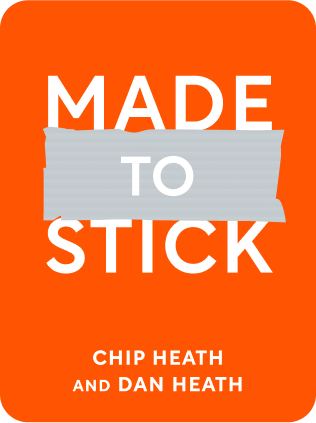

This article is an excerpt from the Shortform book guide to "Made to Stick" by Chip Heath and Dan Heath. Shortform has the world's best summaries and analyses of books you should be reading.
Like this article? Sign up for a free trial here .
Do you have to be an amazing writer or speaker to deliver creative messaging? Is there a simple formula for effectively getting your ideas across?
You don’t have to be a creative genius to communicate your message well. Chip and Dan Heath show you what to do through numerous examples of messages that have succeeded and others that have bombed. Rather than sweating over an original presentation, you can follow their “stickiness” template or even emulate someone else’s idea that worked.
Keep reading to learn the formula for creative messaging.
Chip and Dan Heath: How to Make Your Message Stick
In our overstimulated and distracted society, great ideas and important messages often fail to gain traction, while bad ideas and falsehoods, such as urban legends, go viral and seem to stick around forever.
Made to Stick by brothers Chip and Dan Heath explores what makes some messages “stick” in the public’s consciousness while others go unheard or unremembered and explains how to create an idea that sticks. Based on a wide-ranging examination of psychology research, popular culture, and news headlines, they identify six criteria for creative messaging.
Ideas or messages that stick are those that are understandable, memorable, and have a lasting impact. An example of a story that succeeds on all three levels is the perennial Halloween candy tampering scare.
Poisoned candy rumors originated in the 1960s, followed later by stories about sick people putting sharp objects into apples at Halloween. Parents searched their kids’ candy, schools and fire departments offered “safe” Halloween events, and hospitals offered to X-ray kids’ treat bags. But it was largely false. The story was understandable and memorable, and it had a lasting impact: it changed people’s behavior, even to today.
With all of the ideas, especially false ones, competing for people’s attention, getting important messages across is daunting. We all have messages and ideas we need to deliver. For instance, teachers must explain mitosis or introduce algebra to students, and managers have to get employees to implement company initiatives. But anyone can deliver creative messaging by following a simple formula—SUCCESs: Make it Simple, Unexpected, Concrete, Credible, Emotional, and make it a Story.
Creative Messaging Isn’t Rocket Science
You don’t need to be a creative genius to create a sticky message. In 1999, researchers analyzed 200 award-winning advertisements and found that 89 percent of them fell into one of six categories or templates, most of which involved the principle of unexpectedness.
For example, one category was “extreme consequences.” This category included an ad for a powerful car stereo with the exaggerated ability to collapse a bridge with its vibrations. Another example of this type of creative messaging is the World War II slogan and ad campaign, “Loose Lips Sink Ships.” (Shortform note: The point was to urge people to be careful not to say anything that a spy might be able to use.)
When researchers tried applying the six ad templates to 200 less-successful ads, they found that only two percent fit a template, which suggests that creative people use what works (templates), while less creative people reinvent the wheel.
The lesson is that if you want your message to stick, emulate how successful people have done it using the six SUCCESs principles.
The Curse of Expertise
Anyone can apply these six principles to deliver creative messaging—they’re mostly common sense—yet a majority of people produce opaque, mind-numbing prose instead. The reason people don’t take simple steps to make their messages compelling is that they’re blinded by a cognitive bias known as “the curse of knowledge.” Instead of keeping their message simple and concrete, they lapse into abstractions because they assume their listeners have the same level of knowledge or expertise as they do.
A Creative Messaging Success Story
Here’s how one potentially dull message was shaped and communicated effectively.
In 1992, the nonprofit Center for Science in the Public Interest analyzed the ingredients of movie theater popcorn. A medium-sized serving had 37 grams of saturated fat, compared to the USDA’s recommendation that people consume no more than 20 grams a day. CSPI’s challenge was to put the numbers into a meaningful context—to make the message stick that movie popcorn is very unhealthy.
The organization called a press conference at which they displayed a serving of movie popcorn juxtaposed with three meals: a bacon-and-eggs breakfast, a Big Mac-and-fries lunch, and a complete steak dinner. The message: One serving of movie popcorn has more saturated fat than a day’s worth of high-fat meals. The story caught the attention of the major television networks and newspapers as well as late-night comedians.
CSPI had an important message, they communicated it so that people would hear and care about it, and the message stuck. They did it despite lacking a sensational topic, a multimillion-dollar budget, or a staff of professional marketers. You can craft equally effective messages.

———End of Preview———
Like what you just read? Read the rest of the world's best book summary and analysis of Chip Heath and Dan Heath's "Made to Stick" at Shortform .
Here's what you'll find in our full Made to Stick summary :
- What makes some messages “stick” while others go unremembered
- The six criteria for shaping your message so it resonates
- Why many companies are blinded by “the curse of knowledge”






